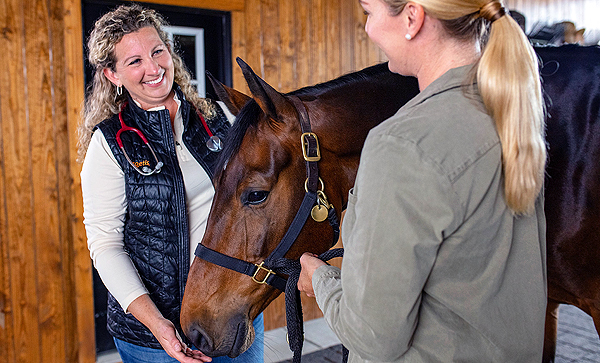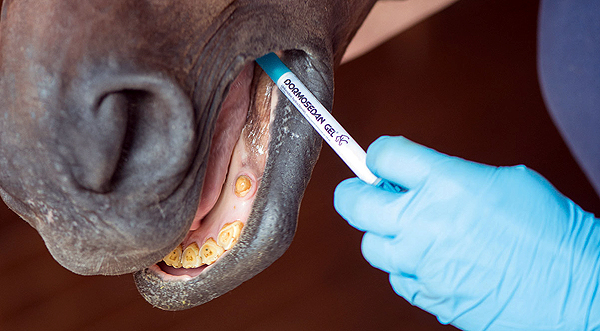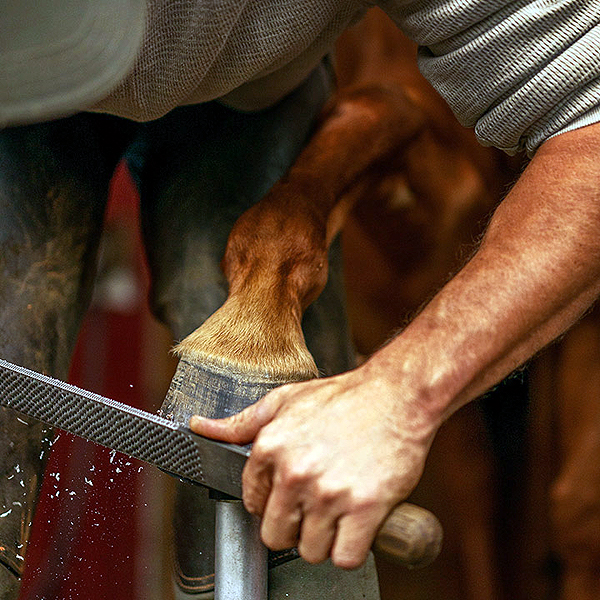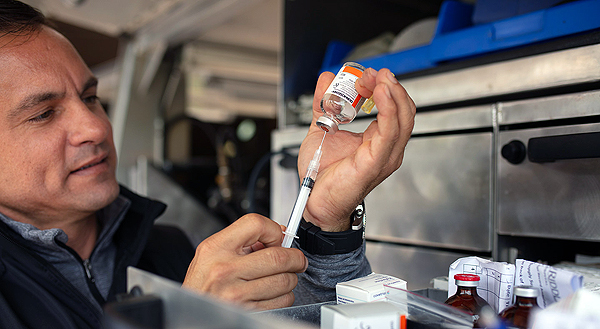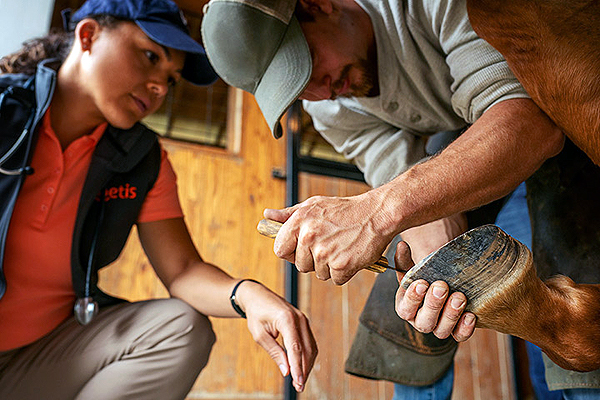Equine Sedation: A Guide for Horse Owners
By Jeff Hall, DVM, Managing Equine Technical Services Veterinarian, Zoetis
It’s not uncommon for horse owners to feel anxious about the use of sedatives in their pets, but the truth is that sedatives are commonly used, safe and often easy to administer. In many cases, they aren’t just helpful—they’re essential. Horses are powerful animals, and their size and fight-or-flight instincts can make for dangerous situations for themselves and those around them. There are also parts of a horse that aren’t physically visible or accessible to a veterinarian, such as their teeth, unless the horse is sedated and relaxed.
When used appropriately, sedatives increase a horse’s comfort in stressful situations, ensuring your safety and that of the veterinarians and handlers working with them.
Here are some important things to know about sedation, including types of sedatives, methods of administration and common use cases.
Types of equine sedation
A great way to break down different types of sedation is by their method of administration. The three primary categories are:
- Oral sedation
- Standing injectable sedation (IM and IV)
- General anesthesia
Oral route of administration
Common drugs that are given to horses by mouth include alpha-2 agonists and phenothiazines. Alpha-2 agonists cause muscle relaxation, sedation and pain relief. Phenothiazines cause relaxation but allow the horse to maintain arousability and avoidance behaviors. Common examples of these drugs include Dormosedan® Gel (detomidine hydrochloride) and xylazine, both alpha-2 agonists, and acepromazine, which is a phenothiazine.
Dormosedan Gel is the first and only sedative approved by the FDA specifically for horse owner administration. It’s a mild standing sedative prescribed by veterinarians for horse care and husbandry procedures such as farrier work, body clipping and general restraint.
Acepromazine works by blocking dopamine receptors in the central nervous system. The effects of acepromazine can vary depending on the horse and formulation, but they’re typically milder and shorter-lasting than an alpha-2 agonist like Dormosedan Gel.
Common uses for oral sedatives
- Routine care: Oral sedatives can make routine husbandry procedures less stressful for horses and handlers. Think sheath cleaning, bandage changes, mane pulling or farrier work.
- Stressful environments: Fireworks, loud events or new settings can spook your horse. Using light sedatives ahead of events like these helps ensure your horse stays calm, avoiding injury.
- Trailer loading: Sedative use encourages calm behavior and can help reinforce positive learnings. (Note: Never trailer a sedated horse without veterinary direction.)
- First turnout after stall rest: Using a sedative can reduce the risk of reinjury due to pent-up energy if your horse is just returning from being on stall rest after an injury.
Standing injectable route of administration
Injectable sedatives, given intramuscularly (IM) or intravenously (IV), are administered by a veterinarian. The IV route has the fastest onset of effect and the greatest intensity but generally leads to a shorter duration of action. The IM route varies depending on the drug but generally lasts longer than IV and has less intensity.
IM sedation is typically administered in the triangular muscular region located on the side of the neck. Onset occurs within 10 to 15 minutes, faster than an oral sedative but slower than an IV. It offers moderate sedation and is generally used for less intensive procedures.
IV sedation delivers rapid and strong sedation, often within 5 minutes. It’s ideal for procedures requiring greater control or deeper sedation. IV sedatives are injected into the jugular vein and should only be handled by veterinarians due to the risk of improper administration.
Acepromazine, xylazine and Dormosedan® Sterile Solution (detomidine hydrochloride) are examples of commonly used IV sedatives. If any of those sound familiar, that’s because they are the same active ingredients as the orally administered sedatives we discussed.
Below are some common situations where your veterinarian might administer IV sedation.
- Routine care
- Dental examination and floating: Due to the anatomy of the equine skull, it’s very challenging to examine a horse’s mouth without sedation and a mouth The noise of the equipment and the feeling in the mouth can be unnerving for horses, making sedation essential for precise and stress-free dental care.
- Hoof trimming and corrective shoeing: Some horses may have painful conditions that can make it hard to stand on three legs while a farrier works on them. Sedation can make it easier to get the job done quickly, thereby minimizing the time of discomfort.
- Medical procedures
- Injuries: In cases of injury like a wound or laceration, sedation allows for more complete evaluation and repair (along with a local anesthetic to reduce sensation).
- Diagnostic imaging (radiographs, ultrasounds): Horses need to remain still for clear, accurate diagnostic imaging, and sedation helps veterinarians effectively image horses the first time around. It also protects expensive equipment.
- Standing surgical procedures: Sedation allows veterinarians to perform procedures such as eye removal, sinus surgery, laparoscopy, and tooth or mass removal so that general anesthesia and recovery can be avoided.
- Joint injections: If your horse receives joint injections for conditions like osteoarthritis, sedation can help ensure the treatment is administered safely and in the appropriate spot.
General anesthesia: administered by a veterinarian
General anesthetics are the most powerful sedatives available and cause complete loss of consciousness. They’re administered by IV for induction of anesthesia and may be maintained via repetitive injections, a constant rate of infusion or by gas-inhaled anesthetics through an endotracheal tube using an anesthesia machine that breathes for the horse. They’re always administered by a veterinarian and technician and are usually required for advanced medical or surgical procedures such as castration, colic surgery, arthroscopy or fracture repair. Anesthetics require constant monitoring by your veterinary team.
Recovery can take place on grass (like after routine castration), in a padded recovery stall (like after colic surgery), or in a sling or inflatable raft in a pool (like in neurologic or fracture repair cases) depending on the facility and availability.
Make informed choices with your veterinarian
Your veterinarian is always your best resource when it comes to equine health topics, including sedation. Don’t be afraid to be proactive and discuss your concerns by asking questions like:
- Will my horse need to be sedated during the exam or procedure?
- What type of sedative will be used, how does it work and how long will it last?
- How long until my horse can graze, eat or drink after being sedated?
- What’s the withdrawal period for the sedative (important for competing or racing horses)? You can also reference USEF Guidelines and Rules for Drugs and Medications to ensure you’re following proper protocols.
IMPORTANT SAFETY INFORMATION
Do not use DORMOSEDAN GEL in horses with pre-existing atrioventricular (AV) or sinoatrial (SA) block, with severe coronary insufficiency, cerebrovascular disease, respiratory disease, or chronic renal failure. Do not use in anesthetized or sedated horses, or in conditions of shock, severe debilitation or stress due to extreme heat, cold, fatigue or high altitude. Do not use in horses intended for human consumption. Handle gel-dosing syringes with caution to avoid direct exposure to skin, eyes or mouth. See full Prescribing Information.
Do not use DORMOSEDAN STERILE SOLUTION in horses with pre-existing atrioventricular (AV) or sinoatrial (SA) block, with severe coronary insufficiency, cerebrovascular disease, respiratory disease, or chronic renal failure. Intravenous potentiated sulfonamides should not be used in anesthetized or sedated horses. Careful consideration should be given to horses approaching or in endotoxic or traumatic shock, to horses with advanced liver or kidney disease, or to horses under stress from extreme heat, cold, fatigue, or high altitude. Do not use in horses intended for human consumption. Handle dosing syringes with caution to avoid direct exposure to skin, eyes or mouth. See full Prescribing Information here.
All trademarks are the property of Zoetis Services LLC or a related company or a licensor unless otherwise noted. Dormosedan is a registered trademark of Orion Corporate, distributed by Zoetis under license.
© 2025 Zoetis Services LLC. All rights reserved. DOR-00138










